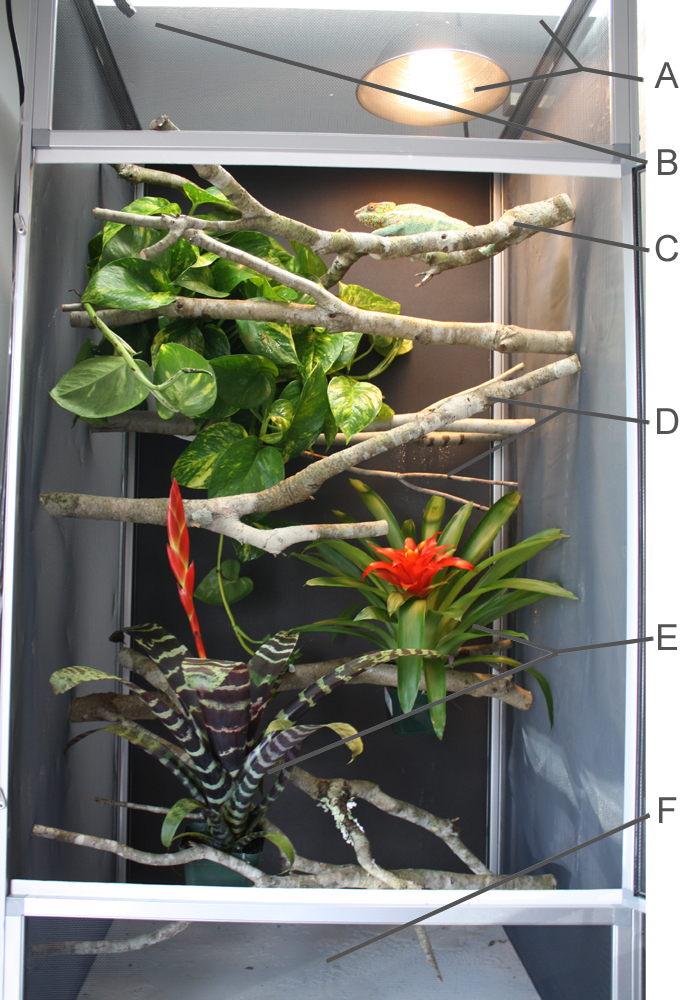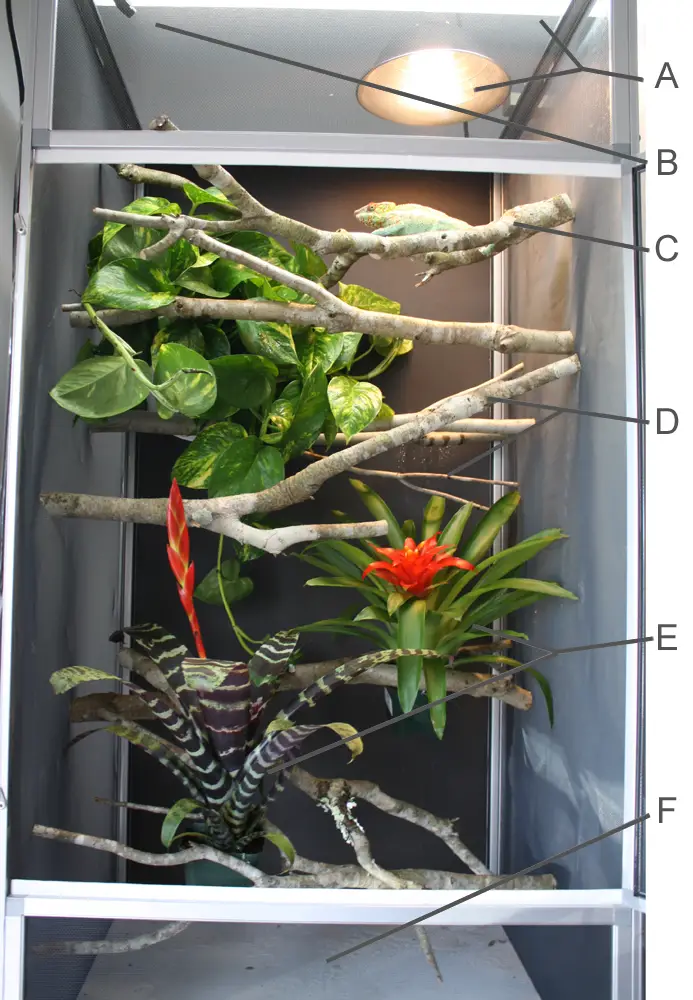Paragraph 1:
Are you considering getting a chameleon as a pet? If so, it’s crucial to understand the importance of setting up the perfect habitat for your new reptile friend. A chameleon cage is not just a mere box to keep your pet in; it’s a simulated environment that mimics their natural surroundings and helps them thrive and live a healthy life.
Paragraph 2:
In this guide, we’ll take you through the essential steps of setting up a chameleon cage, from choosing the right size and type of enclosure to selecting the correct lighting and humidity levels. With our expert tips and tricks, you’ll be able to create a comfortable and safe home for your chameleon that will allow them to live happily and grow into a healthy adult.
To set up a chameleon cage, choose a large enclosure with plenty of branches and foliage for climbing and hiding. Use a substrate like coconut coir or sphagnum moss for the bottom. Provide a heat source, such as a basking lamp, and a UVB light. Mist the cage daily and provide a water dish for drinking. Add live plants for decoration and humidity. Clean the cage regularly to prevent bacteria buildup.

How to Set Up a Chameleon Cage?
Chameleons are fascinating creatures that are popular as pets. They are unique and require specific care to thrive. One of the essential aspects of chameleon care is providing them with a suitable habitat. In this article, we will guide you through the process of setting up a chameleon cage.
1. Choosing the Right Cage
The first step in setting up a chameleon cage is choosing the right one. Chameleons require a spacious and well-ventilated cage that mimics their natural habitat. The cage should be large enough to allow your chameleon to climb and move around freely.
A screen cage is the best option for chameleons as it provides good ventilation and allows for better airflow. The cage should be at least 36 inches tall and 24 inches wide to provide enough space for your chameleon.
To create a safe and comfortable environment for your chameleon, add branches, vines, and plants to the cage. These will provide hiding spots and perches for your chameleon to climb on.
2. Lighting
Chameleons require UVB lighting to stay healthy and thrive. UVB lighting mimics the sun’s rays and helps chameleons produce vitamin D3, which is essential for their bone health.
You should provide your chameleon with a UVB bulb that covers at least two-thirds of the cage. The bulb should be replaced every six months to ensure it is providing enough UVB light.
In addition to UVB lighting, your chameleon will also need a basking bulb. The basking bulb provides heat and helps regulate the temperature in the cage. The basking bulb should be placed at one end of the cage, creating a temperature gradient.
3. Humidity and Water
Chameleons require high humidity levels to stay healthy. You can increase the humidity in the cage by misting it with water several times a day.
To ensure your chameleon has access to clean water, provide a water dish in the cage. The dish should be shallow and easy to access for your chameleon. Change the water daily to prevent bacteria growth.
4. Substrate
Chameleons require a substrate that is easy to clean and maintain. The best substrate for chameleons is paper towels or reptile carpet. These substrates are easy to clean and do not pose a risk of impaction.
Avoid using loose substrates such as sand, gravel, or wood chips, as they can be harmful to your chameleon if ingested.
5. Feeding
Chameleons are insectivores and require a diet of live insects. Feed your chameleon a variety of insects, such as crickets, mealworms, and waxworms. Dust the insects with calcium and vitamin supplements to ensure your chameleon is getting the nutrients they need.
Feed your chameleon once a day, offering as many insects as they can eat in 15-20 minutes. Remove any uneaten insects to prevent them from escaping and potentially harming your chameleon.
6. Cleaning and Maintenance
Cleaning and maintaining the chameleon cage is essential to keep your chameleon healthy. You should spot clean the cage daily, removing any feces or uneaten insects.
Once a month, you should deep clean the cage, removing all the substrate and disinfecting the cage with a reptile-safe cleaner.
7. Benefits of Setting Up a Chameleon Cage
Setting up a chameleon cage provides various benefits for both you and your chameleon. A well-maintained cage provides a safe and comfortable environment for your chameleon to thrive.
Additionally, watching your chameleon climb and move around the cage can be a fascinating and rewarding experience.
8. Vs. Buying a Pre-Made Cage
While pre-made chameleon cages are available, setting up your own cage provides several benefits. You can customize the cage to meet your chameleon’s specific needs and preferences.
Additionally, setting up the cage yourself allows you to become more familiar with your chameleon’s care requirements and helps you provide better care.
9. Common Mistakes to Avoid
When setting up a chameleon cage, there are several common mistakes to avoid. These include using the wrong substrate, providing inadequate UVB lighting, and not maintaining proper humidity levels.
It is essential to research and understand your chameleon’s care requirements before setting up their cage to avoid making these mistakes.
10. Conclusion
Setting up a chameleon cage requires careful planning and attention to detail. By choosing the right cage, providing proper lighting, humidity, and substrate, and feeding your chameleon a healthy diet, you can create a safe and comfortable environment for your chameleon to thrive.
Remember to clean and maintain the cage regularly and avoid common mistakes to ensure your chameleon stays healthy and happy. With proper care, your chameleon can live a long and fulfilling life as your loyal companion.
Freequently Asked Questions
Setting up a chameleon cage can be a tricky process, especially for beginners. Here are some frequently asked questions and their answers to help you get started!
What size should the chameleon cage be?
The size of the cage depends on the size of the chameleon. It is recommended to have a cage that is at least 2 feet tall and 2 feet wide for an adult chameleon. The bigger the cage, the better, as chameleons need a lot of space to climb and move around. It is also important to have plenty of branches and plants for the chameleon to climb on.
When choosing a cage, make sure it is made of a material that is easy to clean and sterilize, such as glass, PVC, or screen. Avoid using wood or other porous materials that can harbor bacteria and parasites.
What kind of lighting does a chameleon need?
Chameleons need both UVB and UVA lighting to stay healthy. UVB lighting helps the chameleon produce vitamin D3, which is essential for absorbing calcium and maintaining strong bones. UVA lighting helps regulate the chameleon’s circadian rhythm and behavior.
The UVB light should be on for 10-12 hours a day, and replaced every 6-12 months, as the bulbs lose their effectiveness over time. The UVA light can be on for 12-14 hours a day. Make sure the lights are positioned in a way that the chameleon can bask in the light, but also have shaded areas to cool off.
What should I feed my chameleon?
Chameleons are insectivores, which means they eat insects. Crickets, mealworms, waxworms, and roaches are all good options. It is important to gut-load the insects before feeding them to the chameleon, which means feeding them nutrient-rich foods, such as fruits and vegetables, to pass the nutrients along to the chameleon.
Supplementing the chameleon’s diet with calcium and vitamin D3 is also important. Dust the insects with calcium powder before feeding them to the chameleon, and provide a vitamin supplement once or twice a week.
What is the ideal temperature and humidity for a chameleon cage?
Chameleons need a temperature gradient in their cage, with a basking spot that is around 85-90°F during the day and a cooler spot that is around 70°F at night. A heat lamp can be used to create the basking spot, and a ceramic heat emitter can be used to maintain the nighttime temperature.
The humidity in the cage should be around 50-70%. This can be achieved by misting the cage several times a day, or by using a misting system. It is important to monitor the humidity levels with a hygrometer, as too much or too little humidity can lead to respiratory problems or dehydration.
How often should I clean the chameleon cage?
Chameleon cages should be cleaned regularly to prevent the buildup of bacteria and parasites. Spot clean the cage daily by removing any feces or uneaten insects. Every 2-4 weeks, do a deep clean by removing all the branches and decorations, wiping down the cage with a reptile-safe cleaner, and replacing the substrate.
It is also important to quarantine any new chameleons for at least 30 days before introducing them to the rest of the chameleon population, to prevent the spread of diseases.
How to set up a chameleon cage
In conclusion, setting up a chameleon cage requires careful consideration and attention to detail. By following the steps outlined in this guide, you can create a safe, comfortable, and stimulating environment for your pet chameleon. Remember to prioritize proper lighting, humidity, and temperature levels, as well as providing ample hiding places and climbing structures. With the right set up, your chameleon can thrive and bring joy to your home for years to come.
It’s essential to research the specific needs of your chameleon species to ensure that you’re providing the best possible care. Don’t be afraid to ask for advice from fellow chameleon owners or consult with a veterinarian who specializes in reptiles. With a little bit of effort, you can create a beautiful and healthy habitat that will keep your chameleon happy and healthy.
Finally, remember that setting up a chameleon cage is just the first step in providing a fulfilling life for your pet. Regular maintenance, feeding, and interaction are just as important in ensuring that your chameleon remains healthy and happy. With patience and dedication, you can enjoy a long and rewarding relationship with your beloved chameleon.

